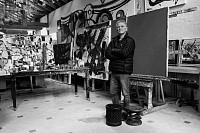BIOGRAPHY

ROBERT SLINGSBY
(b. 1955, South Africa)
For over five decades, Robert Slingsby has pursued a singular and uncompromising artistic journey, grounded in fieldwork, research and a steadfast commitment to documenting the complexities of Africa’s traditional cultures. A five-year education at the Vrije Akademie in Den Haag, Holland, a crucible of classical training infusing countercultural ideas, innovative expression and revolutionary politics, formed the foundation for Slingsby’s development as a multidisciplinary artist. His practice encompasses painting, drawing, etching and sculpture, marked by precision and intentionally intimate engagement with Africa’s traditional mark-makers, both ancient and contemporary.
“I first visited the Richtersveld as a child, when my father’s car broke down there on our way to Windhoek; at the time, it was just another place most drove past on their way north. As the blinding sun beat down on us as we waited for help, I felt an immediate connection to the earth beneath my feet and inscribed on the rocks. Today, the Richtersveld is a destination, drawing diamond mining magnates, zama zamas, river rafters, supermarket chain suppliers and rare plant smugglers; each seeking to extract wealth from the earth. But for me, the Richtersveld remains my connection to the sacred earth and the life source from which my art flows.”
Slingsby’s work is therefore the outcome of immersive field research in some of the most remote regions of the continent. His engagement with Africa’s art, particularly the petroglyphs of the Richtersveld and through this in-depth documentation of threatened indigenous knowledge systems, his art confronts the realities of marginalisation, land dispossession, environmental degradation and the relentless erosion of ancestral culture under modern expansion.
In his current body of work, a return to oil on canvas, Slingsby draws from this deep wellspring of lived experience and decades of observation. These complex, layered compositions are both a reckoning and a tribute, anchored in his enduring fascination with ‘the line’, a visual and conceptual thread that runs through ancient rock markings and contemporary mark-making alike. His paintings are precise and visceral: they chart not only the landscape, but the emotional and spiritual terrains of communities standing at the edge of erasure. Through them, he invites viewers into a world shaped by encounter, endurance, embedded beauty and observation.
SELECTED SOLO AND GROUP EXHIBITIONS
2025 The Archive of Unspoken Things, Everard Read Franschhoek
2024 Winter Group Show, Everard Read Franschhoek
25th Anniversary Group Exhibition, Knysna Fine Art
2023 Season’s Greetings Summer Group Exhibition, Everard Read Franschhoek
What I Think About When I Look At The Cosmos, Group Exhibition, Everard Read Franschhoek
2022 Spring, A Group Show, Everard Read Franschhoek
The Big Picture, Group Exhibition, Knysna Fine Art
2021 Summer, a Group Show, Everard Read Franschhoek
2020 Classrooms of Dus, solo exhibition, Knysna Fine Art
Imago, group exhibition, Everard Read Franschhoek
2019 In/Dependence, Circa Gallery, Everard Read Johannesburg
2017 Great Rift, solo exhibition, Everard Read Franschhoek
2015 I am, solo exhibition, Royal College of Art, London
2014 Crossing The Line, solo exhibition, Barnard Gallery, Cape Town; 'Crossing the line' book accepted into Thomas J. Watson Library / Metropolitan Museum of Art, New York
2012 Money and God in His Pocket, Barnard Gallery, Cape Town
2011 Just Injustice, Sandie Lowry, Kensington Park Rd pop-up, London
2010 CC - Unlimited Power, UCT Irma Stern Museum
2008 Square 1 Gallery, London; Art International, group exhibition Nassau, Bahamas
2007 Excess(ive) baggage, Square One Gallery, London
2006 Bones of the rusting carpet, Square One Gallery, London
2005 Power house, Bell-Roberts Contemporary Art Gallery; Art International Nassau, Bahamas
COLLECTIONS:
ABSA Bank Collection
Artoteek, Dutch Municipal Collection
Berman Brothers Collection
Bunders Bank, Germany
Cape of Good Hope Bank
Department of Foreign Affairs
Deutsche Bank, Johannesburg
Ernst & Young
Investec Bank
Leeu Collection
Pietersburg Art Museum
Rand Merchant Bank
Sanlam Public Collection
SASOL Public Collection
SEEFF Holdings
Slingsby’s art is represented internationally in collections including:
South African Embassy, Brussels
South African Reserve Bank
Stonehage Collection
William Humphries Art Museum
Witwatersrand University Collection



